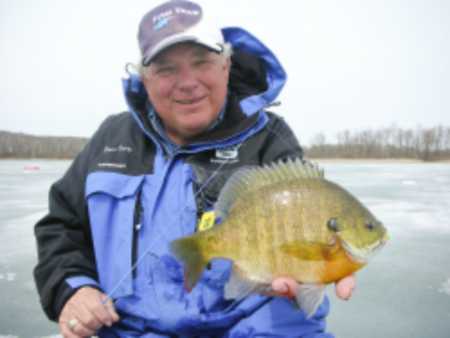| March is the Kindest Ice Fishing Month
Living in a place
where ice covers the lakes through the month of March provides
you with one of our sport’s greatest pleasures: ice
fishing for active fish in nice weather.
The sun, functioning mainly as a light source in Jan and Feb,
begins to add warmth to its list of features, hitting you
more directly. In the midday hours, layers of clothing can
come off instead of going on. Daylight hours are longer, fish
are stirring, preparing for spawning, eating more.
The fishing is as good as the living.
If you fish through the ice in the month of March, you wonder
how travel agents sell any tickets for people to go to warmer
climates.
Dave Genz wonders this every year, as he rarely fights crowds
on the best fishing spots, as he wonders why people would
rather sit in their boat out in the garage than get in on
some fantastic fishing.
For today, let’s key on panfish species.
Sunfish, crappies, jumbo perch.

The ice begins to fade as February gives way to March,
but the action gets really good for those who continue
to drill holes. Here, Dave Genz holds a brute bluegill
taken in shallow water. (Photo: trueblueicefishing.com) |
During the late ice period, oxygen levels increase in
shallow water. The same dynamics that cause many people
to think the ice is no longer safe triggers shallow fish
movements and increased activity.
“People see water on top of the ice, or the ice
breaking away from shore,” says Genz, “and
they think (ice fishing) it’s over for the year.
That’s what re-oxygenates the shallows and draws
life in there.” |
Genz makes a study of current conditions at this prime season,
chasing late ice opportunities north until he runs out of
winter. Reluctantly, when it finally is all over, he packs
up his Fish Trap, Vexilar and Strikemaster, and checks to
see if his boat will start.
“That might be different than what other people do,”
he admits, “but if you do it once you’ll look
forward to it.”
This is a little off the subject, but Genz and his fellow
Team True Blue pros are experts when it comes to traveling
to find hot ice bites. Genz has racks in his van to organize
ice gear, and pulls an Arctic Cat snowmobile, rigged for ice
fishing, on a trailer, moving from one hot rumor to the next.
The trend toward traveling as a modern ice angler will gain
momentum in the coming years, because anything this fun and
productive is bound to catch on.
“People think of pulling their boat and dumping it in
the water all over the place,” says Genz, “but
for some reason, most people only go ice fishing close to
home.”
The perspective that comes from fishing a wide variety of
waters is priceless, stresses Genz. “That’s how
you see what works,” he says, “no matter where
you go.”
Finding Fish in March
Sunfish and Crappies
Let’s look at where to search for iced-over bluegills
and crappies, during the late-ice period.
Any lake that still has plenty of ice in March has had ice
on it long enough to have driven most panfish out of the shallows.
This is not always true, but on most lakes, even the shallow
weedbeds that had plenty of fish at first ice become dead
zones at midwinter. As weeds die off and oxygen levels decrease
in shallow water, most fish are forced to head for deeper
ground.
But as spring approaches, a return to shallow water is a classic
movement.
“The weeds don’t even have to be growing,”
explains Genz. “When the oxygen levels increase again
in the shallows, that can bring the fish in.”
But when you find new green weeds, you often find a panfish
bonanza.
“Weeds grow under the ice in the winter,” says
Genz. “Anywhere sunlight can get through and penetrate
to the bottom, that can get the weeds growing again. Most
of the time, you find them by having pieces of green weeds
come out as you finish drilling a hole. But I always look
for them by looking down the hole, too. If you find new green
weeds, don’t leave that area until you check it thoroughly.”
One big secret to finding shallow March fish is keying on
big bays on the north end of the lake. That’s the zone
that gets most of the daytime sunshine, and what you have
heard about this is true. Particularly if your fishing time
is limited, don’t waste any of it drilling holes on
the south end.
As always, fishing is a big experiment. If you don’t
find sunfish and crappies in the shallows, a great secondary
search area would be sticky-bottom areas in the middle depths.
Genz was the guy who broke this concept in his book, “Bluegills!”
“It’s still a place most people don’t look,”
says Genz.
Look on any contour map of any lake. Find places where the
contour lines are relatively far apart. That indicates a ‘flat,’
either leading to the first dropoff or between dropoffs.
Shallow flats, even when they’re in the middle of the
lake, can have weeds on them. But at the middle depths (deeper
than weeds would grow on a given lake), can be flats that
house an abundance of burrowing insects.
If the bottom consistency is not too hard and not too soft,
you have probably found a sticky-bottom flat. If the flat
is big, you might have to spend some time searching it, drilling
lots of holes, to find fish. But if you find an area holding
fish, it can be one of the greatest ice-fishing experiences
of your life.
“As you search across these areas,” says Genz,
“concentrate along the base of the slope if you can
find it. Fish will use that base like a wall.”
Jumbo Perch
“If you’re a perch fisherman,” says Genz,
“this is the time of year when scattered pods of fish
turn into big schools, and they move toward the spawning grounds.
Look shallower than you do at midwinter. Look in reeds and
weed beds. If you’re fishing in an area that’s
going through a high-water cycle, check flooded brush.
“Perch string their eggs on something; they don’t
lay them on the bottom. They string them across weeds or brush,
so those are the areas to fish at this time.”
As with the sunfish-crappie suggestion, if shallow cover is
not holding perch, look for those same sticky-bottom flats
and you might find big perch on them.
Safety at Late Ice
Safety is always number one, but during the late-ice period
it’s especially important.
The ice is as thick as it’s going to get, but eventually
begins to rot away.
Genz always wears a life jacket and urges all ice anglers
to do the same.
During the pleasant weather of March– and even into
April in the northern reaches of the Ice Belt– great
fishing goes begging every year.
Note: Dave Genz, known as Mr. Ice Fishing, was the primary
driver of the modern ice fishing revolution. He is now the
captain of Clam’s Team True Blue, an elite pro staff
dedicated to helping people catch fish through the ice. For
real help learning to catch fish, go to www.trueblueicefishing.com
|

